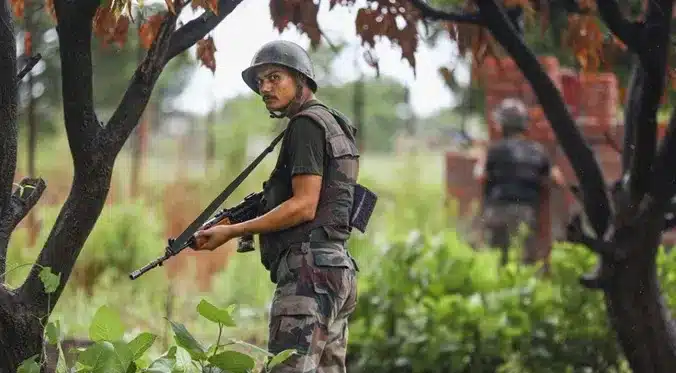What’s in today’s article?
- Why in News?
- New pattern emerging
- Reasons behind this new emerging pattern
- Way forward
Why in News?
- Recent terrorist attacks in the Kathua district of Jammu and Kashmir (J&K) highlight a significant challenge for the Indian government.
- On July 8, five Army soldiers were killed and five injured in an ambush by militants. This incident is part of a troubling trend, with five terror strikes in the Jammu division since June 9, resulting in the deaths of eight security personnel and 10 civilians.
- These attacks indicate a shift in militant focus from the traditionally volatile Kashmir Valley to the previously more peaceful Jammu region.
New pattern emerging
- Attempts to revive militancy in the Jammu region since the past three years
- The recent attacks reflect a concerning pattern of renewed militancy in the Jammu region over the past three years, particularly in the Chenab Valley and south of the Pir Panjal.
- Districts such as Doda, Kishtwar, Ramban, Kathua, Udhampur, Reasi, Rajouri, and Poonch have seen a resurgence in militant activity.
- While the Kashmir Valley has historically experienced frequent terror incidents, the Jammu belt has been relatively peaceful for the past two decades.
- This revival of militancy in an area that was a hotbed in the late 1990s and early 2000s has alarmed the security establishment.
- Statistics
- Since 2021, the Jammu region has experienced 31 terror incidents, resulting in the deaths of 47 security forces and 19 civilians, along with 48 terrorists killed.
- In contrast, the Kashmir Valley has reported 263 terror incidents, with 68 security forces and 75 civilians killed, and 417 terrorists neutralized.
- While the number of incidents in Jammu is significantly lower than in the Valley, the increased frequency and targeted nature of attacks on pilgrims and security forces in Jammu are particularly concerning.
- How is the infiltration happening?
- The 192-km international border (IB) along Jammu is secured by the Border Security Force (BSF), while the 740-km Line of Control (LoC) in the Kashmir Valley and parts of Jammu is under Army control.
- Despite security measures, tough terrain, forested areas along the LoC, and vulnerable patches along the IB may have facilitated fresh infiltration.
- The recent attacks in the Kathua belt, including the July 8 ambush, occurred on an old infiltration route used by militants two decades ago.
Reasons behind this new emerging pattern
- Thinning of the security grid after Galwan incident
- After the 2020 Galwan clashes in eastern Ladakh, which resulted in the deaths of 20 soldiers, a significant number of Army personnel were redeployed from Jammu to the China border, weakening the security grid in Jammu.
- Security experts suggest that this has made the region more vulnerable to attacks.
- India is being engaged at two fronts
- Hostile elements aim to strain India on both the western (Pakistan) and northern (China) fronts.
- With heightened alert in the Kashmir Valley and reduced opportunities for state-sponsored terrorists there, Jammu, with its lowered guard, becomes a more convenient target.
- Aftermath of the abrogation of Article 370
- Following the abrogation of Article 370 in August 2019, the government has touted successes in the Kashmir Valley, evidenced by zero stone-throwing incidents, no strikes, and a tourism boom.
- However, renewed terrorism in Jammu challenges this narrative and might aim to stabilize militant presence in the Valley while stirring insecurity in Jammu.
- Demography of the region
- The area’s demography also raises concerns about potential communal tensions and social unrest due to these attacks.
- Opportunities for terrorists in Jammu region
- The Rajouri- Poonch area had a thinner concentration of security forces.
- This region is equidistant from Shopian and Kulgam in Kashmir, and the Line of Control with Pakistan, making it easier to move between the three regions.
- It was highly unlikely that security forces and police from all three regions would simultaneously launch an operation against the militants.
- Areas in the Pir Panjal range and to its south are also easier to access.
- Any militant crossing over from the lower heights of Jammu have to traverse through multiple high ranges like Pir Panjal before they reach Kashmir Valley.
- This challenges their logistical preparations and motivation.
- Hence shorter and intense contacts have become the norm in the Jammu region
- Terror incidents away from the Valley, where militant ranks have been staring at a leadership vacuum, are high visibility strikes, intended to inflict maximum damage.
- Drying up of the human intelligence
- One of the reasons why forces may have not been able to anticipate the attacks is the drying up of the human intelligence or their network of informers.
- Human intelligence is very important in counter-insurgency operations.
- Even with all their reliance on gadgets and smart ways to avoid surveillance, the terrorists visit the nearest human settlement in order to get logistical support for their survival.
- This is where the role of human intelligence becomes important.
- While militants and their network of overground workers continue to exist, the informers are missing.
- Many security experts attribute the dried-up human intelligence to authorities taking the prevailing peace for guaranteed.
- As per them, the new officers who got transferred to the region didn’t work as hard as they should have on their informer network.
- One of the reasons why forces may have not been able to anticipate the attacks is the drying up of the human intelligence or their network of informers.
Way forward
- A whole generation that fought the terrorists are in their 60s and 70s now. There is no such connect with the younger generation, it will take time to build that trust with the civilians.
- The Village Defence Guards/Committees (VDGs) are also being revived since December 2022.
- The VDGs had to be discontinued amid allegations of crimes such as abduction and rape committed by the members.
Q.1. What are Village Defence Guards/Committees (VDGs)?
Village Defence Guards/Committees (VDGs) are local volunteer groups in India, primarily in Jammu and Kashmir, established to assist in maintaining security and counter-insurgency efforts. Revived in 2022, they play a crucial role in community-based defense.
Q.2. What is Border Security Force (BSF)?
The Border Security Force (BSF) is India’s primary border guarding organization, responsible for securing the country’s borders with Pakistan and Bangladesh. Established in 1965, it operates under the Ministry of Home Affairs and plays a key role in border security, counter-insurgency, and preventing trans-border crimes.
Source: Why is militancy on the rise in Jammu? | Explained
Last updated on January, 2026
→ Check out the latest UPSC Syllabus 2026 here.
→ Join Vajiram & Ravi’s Interview Guidance Programme for expert help to crack your final UPSC stage.
→ UPSC Mains Result 2025 is now out.
→ UPSC Notification 2026 is scheduled to be released on January 14, 2026.
→ UPSC Calendar 2026 has been released.
→ UPSC Prelims 2026 will be conducted on 24th May, 2026 & UPSC Mains 2026 will be conducted on 21st August 2026.
→ The UPSC Selection Process is of 3 stages-Prelims, Mains and Interview.
→ Prepare effectively with Vajiram & Ravi’s UPSC Prelims Test Series 2026 featuring full-length mock tests, detailed solutions, and performance analysis.
→ Enroll in Vajiram & Ravi’s UPSC Mains Test Series 2026 for structured answer writing practice, expert evaluation, and exam-oriented feedback.
→ Join Vajiram & Ravi’s Best UPSC Mentorship Program for personalized guidance, strategy planning, and one-to-one support from experienced mentors.
→ UPSC Result 2024 is released with latest UPSC Marksheet 2024. Check Now!
→ UPSC Toppers List 2024 is released now. Shakti Dubey is UPSC AIR 1 2024 Topper.
→ Also check Best UPSC Coaching in India

















